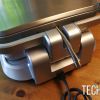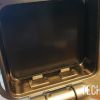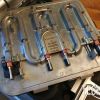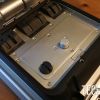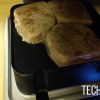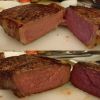 Cooking at home has in some ways become a lost art. The convenience and speed of take-out, fast food, and other available options means that spending time cooking at home isn’t always the most appealing use of one’s time. Thankfully there are ways to make cooking at home faster and easier without losing the flavor and nutritional benefits of cooking. The Cinder Grill still has a few days to go on its Indiegogo campaign, but I was lucky enough to get some time with the grill to see what it can do. Keep reading this full review to see if you should back the Cinder Grill during the last few days of its campaign.
Cooking at home has in some ways become a lost art. The convenience and speed of take-out, fast food, and other available options means that spending time cooking at home isn’t always the most appealing use of one’s time. Thankfully there are ways to make cooking at home faster and easier without losing the flavor and nutritional benefits of cooking. The Cinder Grill still has a few days to go on its Indiegogo campaign, but I was lucky enough to get some time with the grill to see what it can do. Keep reading this full review to see if you should back the Cinder Grill during the last few days of its campaign.
Specifications
- Precision: Your food is held within 1° of the target temperature. Overcooking is impossible; food stays perfectly hot inside Cinder for hours.
- Cooks and Sears: Unlike sous-vide units, Cinder pulls double-duty as a 450° professional searer. No oil necessary, so no smoky stovetop mess.
- No prep or cleanup: No vacuum-sealing, boiling water, or cleaning up pots and pans. When you’re done with Cinder, just wipe the grill down with paper towel.
- Timing: Cinder tells you how many minutes are left. And it holds food at its ideal temperature for hours.
- More than just meat: Cinder is perfect for steaks, scallops, vegetables, pancakes, sandwiches, omelettes, and even chocolate strawberries!
- Dimensions: 13″ x 17″ x 7″ (Width x Depth x Height) when closed, and reaches a maximum vertical height of 18”.
- Cooking Surface: 10″ x 9″.
- Heating Plates: Ceramic-coated aluminum
What’s in the Box
- Cinder Grill
Design
The first thing you’ll notice about your brand new Cinder Grill is its weight. This is a solid and sturdy piece of equipment, weighing in close to 30 pounds. The exterior is a combination of heavy-duty plastics and aluminum, giving the grill a very sleek and stylish look.
Looking directly at the front of the grill, you’ll see the power button on the front left corner, with the removable drip tray just to the right of that. Next to the drip tray is the LCD screen that shows your cooking time, temperature, and any other pertinent information. Next to that is the dial that allows you to set your temperature as well as functions as a multi-function dial for anything else that’s needed. The bottom sides are pretty ordinary, just a slightly sloped exterior with a bit of a channel all the way around the grill leading to a hole that empties into the drip tray.

Moving up slightly, the black walls of the grill itself rise up several inches leading to the grilling surface itself. On the front of the grill you’ll see a button on the right that unlocks the grilling plate for cleaning, as well as a small channel on the front left corner again leading to the drip tray. The grill plates themselves are roughly square (just barely under square at 10” x 9”) with a short lip all the way around. The front left corner of the bottom plate has an opening that will, of course, lead to the drip tray. The top plate is exactly the same as the bottom plate, and it seems that the grill plates can be interchanged if necessary, or at least it doesn’t appear it would cause a problem if you mix up the top and bottom grill plates after cleaning.
The lid attaches to the rest of the grill via a large strong hinge, where the power cord also resides. The lid includes tall sides which cover the bottom grill portion entirely, which helps keep heat in while cooking. The lid tilts slightly to account for uneven food, though it’s only a very slight tilt, so especially uneven food may still not contact the entire grilling surface. The front of the lid has a mechanism to release the top grilling plate, while the lid is surrounded by the lid handle, which allows for the tilting for the lid.

The Cinder Grill is definitely a nice design, and has very solid construction, though there are a few design elements that could be just a bit better. The drip tray in its current form is almost useless. The bottom grilling plate does not have any sort of downward slope, so there’s no way for liquids or other undesirable bits to work their way off of the grilling surface on their own. The channel surrounding the grill also does not funnel in any way to the drip tray, leaving a potential mess around the outside. The lid is also very heavy. This doesn’t pose a problem for sturdy foods, proteins, and the like, but for things like grilled cheese sandwhiches, the heavy lid can pose a bit of a problem.
Ease of Use
You can be up and going with your Cinder Grill in a matter of minutes really. If you want, you can simply remove it from the box, plug it in, set the temperature, place your food on the grill plates, and wait for a bit while your food comes up to temperature. It will work using just those steps, and Cinder will beep when your food is done.

From there you’ll have a choice whether or not to sear your food. Depending on what you’re cooking you may, or may not want to do so. Searing is also pretty easy. When the food is done you’ll need to temporarily remove it from the grill, clean off the grill plates — more on this shortly — and turn the temperature dial all the way up to 450° and the “sear” setting. Once it’s ready, place your food back onto the grill plate, close the lid, and press the button to begin searing. A timer will start for what Cinder will consider a normal searing process. If you prefer a heavier sear, you can leave your food on longer, or open the lid and reposition in order to sear the sides, etc. When you’re happy with your result, you can turn off Cinder, and enjoy your meal.
In the Indiegogo campaign, they talk about how easy Cinder is to clean, and I’ll admit that I didn’t quite have that same experience during my testing. The grill plates are wiped with a damp paper towel in the video, but I was definitely getting some stuck on bits that needed a bit more attention to clean off. Cleanup wasn’t a huge chore by any means, but it definitely wasn’t as easy as it was made to look in the videos.

You can also add in app control for your Cinder. The app is only currently available on iOS devices, but Android support should be coming soon. I’ll talk more about the app in the very next section below, but it does allow you to select the type of food you want to cook, and it will suggest appropriate cooking temperatures and approximate cooking times. The app will then notify you when your meal is ready.
Software
The iOS app connected to the Cinder Grill quickly and easily, and I was able to find many of the types of food I was looking to cook. You can set the temperature for your grill via the app, and it will send notifications to keep you apprised of your progress. You’ll want to be careful after setting your temperature, because an errant tap on the app will change your grill temperature whether you really want it to or not. Some sort of confirmation before changing the temperature might be a worthy addition to the app.
I did find that the app would sometimes get disconnected from the grill as well, even when only a few feet away. This would stop any notifications, meaning I had to stay pretty close to the grill to know when my food was done.

The app also tended to fluctuate wildly when it came to cooking time. In the steak experiment that I’ll talk about in the next section, the app initially gave an estimate of 20 minutes, which quickly shot up to well over an hour, though a short time later the app disconnected, so the final cooking time ended up going about 45-50 minutes.
I also would have liked to see a more robust menu, which Cinder is definitely already working on. Since this is a relatively new way of cooking, not every type of food you might want to cook is included in the app. I had to search for a few things to find the appropriate temperatures since they were not yet included in the app. I am confident that this is just a temporary setback, as the app is still in development.
Performance
Cinder promises sous vide-like performance from a countertop grill, but does it deliver? Yes and no. There are definite advantages to a grill that sous vide just can’t compete with. For example, scrambled eggs, pressed sandwiches, and other items that you just really can’t sous vide. Even with some of these advantages, there are a few things to watch for with Cinder. Pressed sandwiches, for example, really just end up getting completely smashed due to the weight of the lid unless you use some especially hearty and crusty bread.
The lid does tilt slightly for non-flat food, though anything with too much of a slope may not have all areas in contact with the grilling surface. This could be a problem for large chicken breasts, which you’ll want to be especially careful about cooking to temperature. You’ll probably want to double check with a meat thermometer — as you would with sous vide as well — just to be absolutely safe here. Cinder also promises a shorter cooking time than sous vide, though in many cases it was really pretty close.

From those first two paragraphs it may sound as though I’m trashing the performance here, but that’s the last thing I want to do. There are a few things to watch out for, and some things that Cinder maybe doesn’t do quite as well, but it does quite a lot right.
I mentioned scrambled eggs, and Cinder is on-point there. I used Cinder more like a griddle, pouring my eggs scrambled with a bit of milk and some shredded cheddar cheese slowly onto the surface in order to prevent the eggs from slipping into the drip tray. I probably fussed with the eggs a bit more than I maybe needed to also, but the result at the end was very light, fluffy, perfectly cooked scrambled eggs. Keeping the plates at a very specific temperature does a lot of good here. One of the worst culprits when it comes to scrambled eggs is overcooking. Keeping them at the right temperature will give you better results.
Other proteins worked pretty well too. Pork chops were nice and juicy, though there were quite a lot of juices left sitting on the grill plate since nothing really works its way to the drip tray naturally. That tended to happen with most proteins that I tried. I ran a bit of an experiment with some steak. It was obviously very informal, but really I just wanted to see what people thought.
In this case, I had two nearly identical steaks: bone-in NY Strip. They were of nearly identical size, thickness, etc. and both were purchased from the same place. Both were seasoned with salt and pepper. One steak went into a bag with just a tiny bit of olive oil and was prepared in a water bath (sous vide) while the other went directly onto Cinder. Both steaks were fully cooked to approximately medium (I tend to cook to just under medium, but above medium rare).
The Cinder steak was seared on Cinder, while the sous vide steak was seared in a stovetop pan. Both steaks were allowed to rest after searing, and both steaks were cut at nearly the same spot, exposing the interior doneness. The very informal poll found that respondents (friends on Facebook and Google+) overwhelmingly preferred the *appearance* of the sous vide steak. We all know that appearance can be an important aspect of meal presentation, but taste and flavor is obviously more important. So how did the steaks match up there?

Close… very very close. I gave a very slight advantage to the sous vide steak, but it wasn’t by a huge margin at all. Both steaks were quite tender, both had amazing flavor, the sous vide steak was maybe just a touch more juicy, and more to my preference. I finished both steaks though, so I mean, they were both pretty fantastic.
Overall Cinder performs very well. As with most other kitchen tools and cooking methods there are some things that it does better than others, and some areas where it struggles, but if you love to cook, or even if you think you might like to learn to cook, Cinder will be a quality addition to your kitchen.
Price/Value
Cinder has already completely crushed its Indiegogo campaign goal with a few days still remaining, meaning there are plenty of people out there who are willing to spend $500 for this machine. I definitely like Cinder, but I think I’d like it more at even a slight discount of $450. It’s a very sturdy and well-made machine, so the quality and value in construction is there. A few of my concerns can likely also be remedied via an app update or a firmware update for the grill itself. I just feel like I’d be able to more easily recommend Cinder at $400 – $450 instead of $500, especially considering you can buy an immersion circulator for $100 – $150 and get the same (and sometimes better) results in most cases with only a few extra steps.
Wrap Up
Cinder does a lot of things very well. It has a premium build, and comes at a premium price. If it will fit your needs and you can handle the price I definitely recommend giving it a try.


